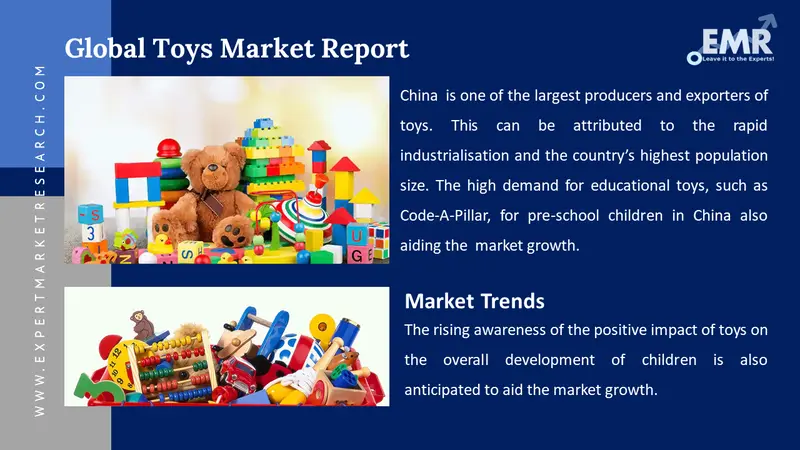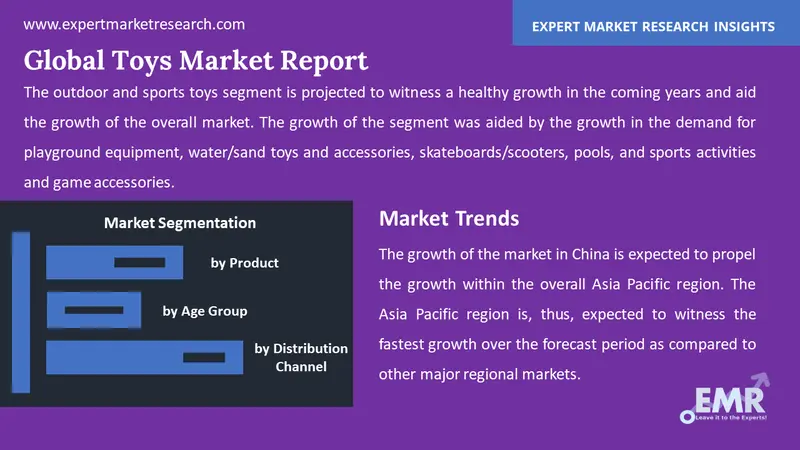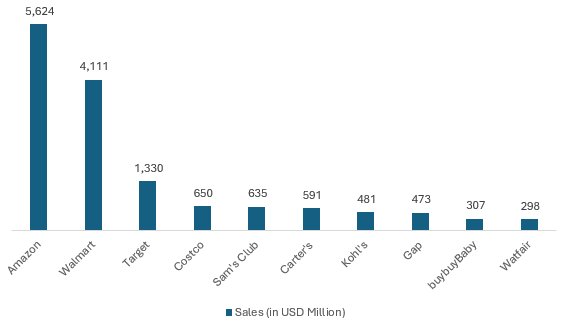
Consumer Insights
Uncover trends and behaviors shaping consumer choices today
Procurement Insights
Optimize your sourcing strategy with key market data
Industry Stats
Stay ahead with the latest trends and market analysis.
Trending Now



The global toys market was valued at USD 108.29 Billion in 2024. Owing to the rising educational focus and innovation, the market will spur at a 4.10% CAGR from 2025 to 2034. By 2034, the industry will attain USD 161.84 Billion.
Base Year
Historical Year
Forecast Year
Asia Pacific is expected to be the most volatile market in the global market for toys.
Country-wise, India and Canada will be the fastest-growing regions during the forecast period.
By product, games and puzzles will gain in the market.
By age-group, the children between 5-10 years will be more indulged in the toys.
In India, the toy exports witnessed a decline from USD 153.89 million in FY 2022-23 to USD 152.34 in FY 2023-24, propelling the growth of toys market globally.
In 2024, McFarlane Toys announced three new DC Collectibles featuring the Batman Cowls that includes 1966 TV series, 1989 movie, and 1993 Knightfall.
Social Services Department officials report Toy Libraries Australia helps 130,000 Australians with $28 million worth of toys, averaging $640 per family.






Value in USD Billion
2025-2034
Toys Market Outlook
*this image is indicative*
| Global Toys Market Report Summary | Description | Value |
| Base Year | USD Billion | 2024 |
| Historical Period | USD Billion | 2018-2024 |
| Forecast Period | USD Billion | 2025-2034 |
| Market Size 2024 | USD Billion | 108.29 |
| Market Size 2034 | USD Billion | 161.84 |
| CAGR 2018-2024 | Percentage | 4.10% |
| CAGR 2025-2034 | Percentage | 4.1% |
| CAGR 2025-2034 - Market by Region | Asia Pacific | 4.9% |
| CAGR 2025-2034 - Market by Country | India | 5.8% |
| CAGR 2025-2034 - Market by Country | Brazil | 4.7% |
| CAGR 2025-2034 - Market by Age Group | Up to 5 Years | 5.0% |
| CAGR 2025-2034 - Market by End Use | Online Channel | 7.1% |
| Market Share by Country | USA | 36.1% |

Read more about this report - REQUEST FREE SAMPLE COPY IN PDF
Technological innovations and pop culture drive demand for engaging toys
One of the major forces that has been driving the global toys market forward is technological integration into toys. Virtual and augmented reality and interactive components are some of the changes that have changed traditional toys into immersive gadgets, educative, and full of entertainment. Such innovation driven by technology not only enhances value play but also captivates those parents who are technologically savvy and appreciate the benefits of entertainment with a tinge of education. For instance, learning possibilities and cognitive growth are stimulated by smart toys that integrate robotics or coding, which makes them extremely desirable in a competitive market.
Pop culture, which is influenced by iconic characters, media franchises, and motion pictures, is a major force pushing the toys demand. The desire for themed items is fueled by popular TV shows and movies, as both kids and collectors want to connect with their favourite characters and tales. Blockbuster franchise licensing agreements result in a constant flow of new items, which accelerates market expansion. The popularity of toys with brands associated with well-known entertainment properties guarantees ongoing consumer interest and boosts sales to a wide range of demographics.
The LEGO Star Wars series is a noteworthy illustration of a pop culture toy. This collection of building sets, which includes recognizable figures, vehicles, and movie scenarios, is directly inspired by the well-known Star Wars film series.One of the contributing factors to this success has been the fact that the Star Wars universe continuously appeals to kids and adults alike. LEGO partnered with one of the most famous and loved brands in order to take advantage of the huge fan base to propel sales and continue this strong market demand.
April 23, 2024
deadmau5 introduced an "ultra-limited" line of plush toys infused with blockchain technology. The 5,000 toys, available in six variants, were sold at his retro5pective shows and online store.
April 19, 2024
Steelbird Baby Toys enhanced child safety by launching baby helmets for cycling and skating, marking a strategic shift towards baby toys for Steelbird Hi-tech India's subsidiary.
The last five years have seen rapid expansion in the global toys industry, fuelled by media franchise licensing and technology breakthroughs. Technological advancements like robotic and programmable smart toys captured customers' attention, and demand was increased by well-known media partnerships. Nevertheless, the market was constrained by tightening regulations and disruptions in the supply chain, which increased expenses and complicated manufacturing, impeding the smooth flow of toys industry revenues.
Companies diversified their supply chains, invested in strict safety compliance, and adopted digital platforms for sales and marketing in order to overcome these obstacles. It is anticipated that the market would keep growing in the upcoming years due to continuous advancements in AR, VR or virtual reality, and educational technology. In order to ensure continuous growth, there will also be a greater focus on eco-friendly toys and adjustments to changing customer preferences and regulatory requirements.
Growing trend of eco-friendly toys can be explained by customers' demand for sustainable materials.
One salient feature of the world toy business in recent times is the proliferation of eco-friendly and sustainable toys. Growing public awareness of environmental issues is raising increasing demands for products that have very little environmental impact. The growing consciousness of the public about plastic pollution and climate impact is what is causing this transformation. The leading companies in using recyclable materials and biodegradable plastics are the following: Green Toys, LEGO. For instance, LEGO is planning to manufacture all its basic products from sustainable materials before the end of 2030. This development is consistent with international initiatives to decrease waste and advance sustainability, and it represents a broader consumer demand for ethical production methods.
Tech-integrated toys are popular, combining physical play with interactive digital features.
The demand for toys is growing all over the world for integrated, interactive toys with technology, boosting the toys market dynamics and trends. Whereas in recent years, along with advanced technology, different toys have also been trending that merge digital and physical play. Artificial intelligence, augmented reality, and connectivity through an app are common features of these toys, which make game time both interesting and instructive. Products such as the educational games from Osmo, for instance, combine digital and physical interfaces to improve learning through interactive play. This pattern illustrates the growing desire for toys that facilitate more than just traditional play by incorporating technology to develop abilities like creativity and problem-solving. Play will certainly change in the future as interactive elements become more widely integrated into toys as technology advances.
Surge in online education and hybrid learning environments to open up new market avenues
Educational toys intended for distance learning present a substantial business opportunity. The need for toys that support and improve virtual learning experiences is rising as a result of the popularity of online education as well as hybrid learning environments. This requirement can be met by educational toys that deliver interactive lessons, integrate with digital platforms, or offer extra learning resources. Businesses can profit from this by creating goods that complement curriculum, foster skill development, and meaningfully involve kids. To bridge this gap, STEM kits that link to online tutorials or coding games that work with educational apps might be offered, attracting the interest of both educators and parents, eradicating the toys market growth challenges.
Growing safety regulations complicate and increase the cost of producing toys
A notable obstacle in the worldwide toys industry is the growing regulatory examination of safety regulations. In recent years, there has been more emphasis on strict safety regulations to protect children from anything potentially harmful in toys, affecting the toys market revenues. For example, the United States Consumer Product Safety Commission reports there have been over 50 toy recalls issued so far in 2023, citing safety concerns. All such pressures add up to the production cost of manufacturers and consequently tangle the supply chain. Thus, to meet these various international standards and regulations, a stern test and quality control must be applied. This may be expensive and time-consuming. To prevent legal ramifications and preserve consumer confidence, toy companies need to make significant investments in safety compliance.

Read more about this report - REQUEST FREE SAMPLE COPY IN PDF
“Toys Industry Report and Forecast 2025-2034” offers a detailed analysis of the market based on the following segments:
Market Breakup by Product:
Market Breakup by Age Group:
Market Breakup by Distribution Channel:
Market Breakup by Region :
| CAGR 2025-2034 - Market by | Age Group |
| Up to 5 Years | 5.0% |
| 5 to 10 Years | 4.8% |
| Above 10 Years | XX% |
| CAGR 2025-2034 - Market by | End Use |
| Online Channel | 7.1% |
| Traditional Stores | 3.4% |
| Departmental Stores | 3.3% |
| Hypermarkets and Supermarkets | XX% |
| Others | XX% |
Available Customizations:
We're here to assist you with tailored insights and solutions to ensure you have all the data you need for your strategic decisions.
Expert Market Research provides tailored reports to meet your unique business requirements. If you cannot find what you're looking for, please contact us at sales@expertmarketresearch.com
Games and puzzles are growing due to their educational value and engagement
From the product perspective, the traction is toward games and puzzles, which is projected to amass a 4.7% CAGR through 2032. With growing awareness about cognitive development and mental well-being, parents are keen on toys that impart education and sharpen the mind. As per toys market analysis, games and puzzles fulfil this demand by enhancing focus, reasoning, and solving problems. Another trend for social interaction and bonding can be found in cooperative and family-friendly games. These are products which can serve both as challenges and entertainment for all age groups, as seen in Ravensburger's offering of strategy games and puzzles. The segment is flexible to use in either instructional or recreational purposes because it can easily adapt to a wide range of age brackets and various interests.
The 5-10 years age group is growing due to demand for educational toys
The segment of 5-10-year-old children is expected to witness a CAGR of 4.3% in the forecast period from 2024 to 2032. This group of children shall be an ideal target for interactive and educational toys, as they lie in that stage when their cognitive and social development is supposed to take place. Parents are increasingly inclined toward spending on toys that develop learning and skills besides mere entertainment, opening up new toys market opportunities. Playsets that are interactive, learning games, and craft and science kits represent the products that correctly meet the developmental needs in the given category. For example, toys offered by LEGO and Osmo come into the hands of children to entertain them in a playful and instructive way, engaging them in problem-solving and critical thinking. The market develops rapidly for a product that justifies the age group's demand for playful moments which should be not only entertaining but satisfying too.
North America Toys Market Dynamics
In North America, the rising demand for toys promoting self-care and social interaction is driving market growth, especially fuelling interest in educational toys in the United States. Some of the top-selling ones include Pokémon, Star Wars, Barbie, Marvel, Squishmallows, Fisher-Price, Hot Wheels, L.O.L. Surprise!, and LEGO Star Wars within the US and Canadian markets.
| CAGR 2025-2034 - Market by | Region |
| Asia Pacific | 4.9% |
| Latin America | 4.6% |
| North America | 4.0% |
| Europe | XX% |
| Middle East and Africa | XX% |
As per toys industry analysis, the growth in educational and STEM toys, in recent times, has further continued to increase the demand for toys across North America. Since more parents are starting to seek toys that facilitate learning and skill development, the growth will continue. Demand is further increased by the growth of hybrid and remote learning programs. Toys that combine entertainment value and instructional value are becoming more and more popular. Examples of this type of toy are Osmo's interactive educational kits and LEGO Education's curriculum-based sets.
The integration of multicultural and bilingual toys is fueling growth in Canada. Culturally inclusive products are becoming more and more popular, such as bilingual LEGO sets, which appeal to Canada's diverse population.
| CAGR 2025-2034 - Market by | Country |
| India | 5.8% |
| China | 5.0% |
| Brazil | 4.7% |
| Australia | 4.3% |
| USA | 3.9% |
| Canada | XX% |
| UK | XX% |
| Germany | 3.8% |
| France | XX% |
| Italy | XX% |
| Japan | XX% |
| Saudi Arabia | XX% |
| Mexico | XX% |
| Market Share by | Country |
| USA | 36.1% |
| Canada | XX% |
| UK | XX% |
| Germany | XX% |
Europe Toys Market Oppurtunities
The European market is driven mainly by the increased focus on sustainability and eco-friendly toys. Environmentally friendly products are gaining increasing significance among European customers, and the market is likely to grow for such sustainable toys. For example, PlanToys adheres to the environmental ideals of the region, using eco-friendly manufacturing techniques and sustainable materials.
Building and construction toys are in wider appeal across 17 European countries, such as Slovenia, the United Kingdom, and Liechtenstein, with LEGO. Besides, high demand for eco-friendly toys and very good purchasing power of consumers contribute a lot to the growth in the European toy market.
Toy markets are increasingly popular, and educational and developmental toys are an example of this, especially in France. This impels the toys industry in France in acquiring a CAGR of 4.3% during the forecast period. Toys that promote social and cognitive growth are becoming more and more important to French parents. Companies like Janod, renowned for their excellent educational toys, are becoming more and more popular. Government programs that encourage early childhood education and parental understanding of the developmental advantages of this trend are in line with a larger European commitment to toys that have educational value.
Asia Pacific Toys Market Trends
Some major factors contributing to the growth of the toy market include growing middle-classpeople and increasing disposable incomes in the APAC region. As the economy develops, more families will have more money to spend on creative and high-quality toys. The Asia-Pacific toy market is anticipated to expand at a CAGR of 4.6% through 2032, according to EMR market analysis. A significant share of this growth is attributable to rising consumer expenditure on upscale and branded toys.
Market dynamics are also being shaped by localised product offerings and cultural factors. Toy businesses are customising their products to correspond with local customs and festivals, for instance, and producing material that is appropriate for a wide range of audiences. The region's blend of technology innovation and cultural diversity is reflected in the popularity of interactive toys and mobile games, which further propels growth.
The Asia Toy & Play Association (ATPA) works closely with regional governments to ensure the development of safe, high-quality toys and organises key events like the Hong Kong Toys and Games Fair and Spielwarenmesse. Additionally, associations like the All India Toys and Baby Products Association (AITBA) and the Asian Committee of Toy Industries play crucial roles in bolstering the toys market share in Asia Pacific region.
According to the Health and Welfare Ministry of Japan, 758,631 infants were born in Japan in 2023 and India's annual birth rate of 25 million children, accounting for nearly twenty per cent of global yearly births, as reported by UNICEF, consequently, enhances the demand for the toys market.
The toy market in India is being greatly supported by the e-commerce sector's explosive rise. Consumers in both urban and rural locations now have easier access to a greater variety of toys because of the growth of internet purchasing platforms. Through 2032, sales in the toy industry are expected to increase at a CAGR of 6.2%.
Latin America Toys Market Driving Factors
The growth of middle-class households and rising urbanisation are the main forces behind the toy industry in Latin America. The desire for high-end, varied toys is rising as disposable incomes rise.
Consumer preferences are also being shaped by the impact of international media and brands. For instance, Hasbro's Monopoly game has gained a lot of popularity because of its well-known brand and media presence. This illustrates a tendency wherein global businesses broaden their appeal in a fast urbanising and rising region by catering to local desires. The Latin American toys demand growth is being driven by the combination of rising purchasing power and the influence of global media.
Middle East And Africa Toys Market Insights
Infrastructure expansion and urbanisation are therefore the key drivers of the growing toy market in the Middle East and Africa. An increase in the number of growing cities, along with an influx of families moving into the metropolitan areas, creates the need for all types of good-quality toys in the cities. Shopping centres and other retail points are increasing within the region, thereby enhancing the accessibility and visibility of toys. It is expected that the toy market in these regions will see a growth of 4.3% during the forecast period with a CAGR.
Additionally, the impact of international media and entertainment is influencing consumer choices. For instance, Disney merchandise and Mattel's Barbie have grown incredibly popular as a result of their robust media presence, which boosts toy sales by utilising well-known characters and themes. This trend emphasises how local market dynamics are combined with global effects, boosting the growth of the toys industry.
Through the introduction of unique and specialised items, startups are securing a foothold in the global toy market. In order to differentiate themselves from well-known brands, they frequently concentrate on cutting-edge trends like tech-integrated toys and sustainable materials. Startups in the toys market can position themselves as dynamic actors in the changing toy industry by fast adapting to customer demands and market upheavals through the use of digital platforms and innovative, creative concepts.
Established in 2013, Osmo makes a distinctive impression on the toy industry with its creative fusion of digital and physical toys. They provide instructional kits that improve learning in subjects like maths and language by utilising augmented reality. Integrating technology to create dynamic, captivating educational experiences is part of Osmo's goal. Their market reach has increased due to recent advances, which have included the expansion of their product line and integration with well-known platforms like iPads.
Since its founding in 2007, Green Toys has been well-known for producing toys that are 100% produced from recycled plastic. They sell kitchen sets, automobiles, and construction blocks. Green Toys targets people that care about the environment by emphasising sustainability and safety. In an effort to boost accessibility and market visibility, the company has recently partnered with major retailers and expanded its product line.
Figure: Online Toy Sales by US Retailers: 2020 (USD Million)

Toys market players presently invest in innovation and sustainability in order to stay competitive. Companies invest money in technology-enabled toys that will combine physical and virtual playing to be entertained and learn. Besides this, toys companies also emphasise processes that are eco-friendly and make use of sustainable materials with plastic wastage reduction in order for the products to be appealing to the environmentally conscious customers. They need to expand into emerging countries and e-commerce platforms in order to reach a wider audience and adapt to the changing retail landscape. These tactics are meant to match changing customer demands and seize fresh chances for growth of the toys market.
The Simba Dickie Group is an internationally operating toy company, headquartered in Fürth, Germany; it was founded in 1982 and offers a very broad range of toys, including dolls, action toys, vehicles, and outdoor toys.
With its headquarters in Tokyo, Japan, Tomy Company Ltd. was founded in 1924 and is one of the most well-known toy manufacturers in the world. From early childhood toys to action figures and collectibles, it is a comprehensive creative developer and manufacturer of toys.
Spin Master Corporation came into existence in 1994, and its headquarters is based in Toronto, Canada. This is an energetic and progressive company in the field of toys and entertainment, recognized by a wide array of popular brands and products within the categories of toys, games, television, and digital entertainment projects.
Moose Toys Ltd. was established in 1985 in Melbourne, Australia, and is a well-respected toy company credited for innovative and creative approaches to designing toys with regard to children's interaction and amusement throughout the world.
*Please note that this is only a partial list; the complete list of key players is available in the full report. Additionally, the list of key players can be customized to better suit your needs.*
May 27, 2024
McFarlane Toys introduced a new DC Classic Darkseid Mega figurine, giving fans an exclusive preview. The design replicated Darkseid's iconic appearances in comics and other media.
May 16, 2024
Mattel's Fisher-Price launched a new line of wooden toys. Their extensive portfolio includes licensed items like a Darth Vader robot and football-themed Little People figures, now adding classic wooden toys.
*While we strive to always give you current and accurate information, the numbers depicted on the website are indicative and may differ from the actual numbers in the main report. At Expert Market Research, we aim to bring you the latest insights and trends in the market. Using our analyses and forecasts, stakeholders can understand the market dynamics, navigate challenges, and capitalize on opportunities to make data-driven strategic decisions.*
Get in touch with us for a customized solution tailored to your unique requirements and save upto 35%!
The market was valued at USD 108.29 Billion in 2024.
The market of the global toys is supposed to expand at a CAGR of 4.10% within the projection period of 2025-2034.
Revenue generated from the toy market is supposed to reach USD 161.84 Billion in 2034.
Some of the major trends that impact the growth of the industry include: integration of technology, sustainability, educational toys, and inclusivity and diversity.
Based on product, categorization of market includes action figures, building sets, dolls, games and puzzles, sports and outdoor toys, plush, vehicles, and others.
The market key players are Tomy Company Ltd., Simba Dickie Group, Moose Toys Ltd., Spin Master Corporation, Hasbro, Inc., Mattel, Inc., Funko, Inc. and LEGO System A/S among others.
The market is segmented into North America, Europe, Asia Pacific, Latin America, Middle East, and Africa.
The Asia-Pacific region is the most growing region in the global toys market due to rising demand involving toys, games, as well as television and digital entertainment ventures.
The key players in the toys market are Tomy Company Ltd., Simba Dickie Group, Moose Toys Ltd., Spin Master Corporation, and Hasbro, Inc.
Explore our key highlights of the report and gain a concise overview of key findings, trends, and actionable insights that will empower your strategic decisions.
| REPORT FEATURES | DETAILS |
| Base Year | 2024 |
| Historical Period | 2018-2024 |
| Forecast Period | 2025-2034 |
| Scope of the Report |
Historical and Forecast Trends, Industry Drivers and Constraints, Historical and Forecast Market Analysis by Segment:
|
| Breakup by Product |
|
| Breakup by Age Group |
|
| Breakup by Distribution Channel |
|
| Breakup by Region |
|
| Market Dynamics |
|
| Trade Data Analysis |
|
| Competitive Landscape |
|
| Companies Covered |
|
Datasheet
One User
USD 2,999
USD 2,699
tax inclusive*
Single User License
One User
USD 4,399
USD 3,959
tax inclusive*
Five User License
Five User
USD 5,599
USD 4,759
tax inclusive*
Corporate License
Unlimited Users
USD 6,659
USD 5,660
tax inclusive*
*Please note that the prices mentioned below are starting prices for each bundle type. Kindly contact our team for further details.*
Flash Bundle
Small Business Bundle
Growth Bundle
Enterprise Bundle
*Please note that the prices mentioned below are starting prices for each bundle type. Kindly contact our team for further details.*
Flash Bundle
Number of Reports: 3
20%
tax inclusive*
Small Business Bundle
Number of Reports: 5
25%
tax inclusive*
Growth Bundle
Number of Reports: 8
30%
tax inclusive*
Enterprise Bundle
Number of Reports: 10
35%
tax inclusive*
How To Order
Our step-by-step guide will help you select, purchase, and access your reports swiftly, ensuring you get the information that drives your decisions, right when you need it.

Select License Type
Choose the right license for your needs and access rights.

Click on ‘Buy Now’
Add the report to your cart with one click and proceed to register.

Select Mode of Payment
Choose a payment option for a secure checkout. You will be redirected accordingly.
Track prices with detailed trend reports.

Analyse trade data for supply chain insights.

Leverage cost reports for smart savings

Enhance supply chain with partnerships.

Gain insights to stay ahead and seize opportunities.

Get insights & trends for a competitive edge.

Track prices with detailed trend reports.

Analyse trade data for supply chain insights.

Leverage cost reports for smart savings

Enhance supply chain with partnerships.

Gain insights to stay ahead and seize opportunities.

Get insights & trends for a competitive edge.

Track prices with detailed trend reports.

Analyse trade data for supply chain insights.

Connect For More Information
Our expert team of analysts will offer full support and resolve any queries regarding the report, before and after the purchase.
Our expert team of analysts will offer full support and resolve any queries regarding the report, before and after the purchase.
We employ meticulous research methods, blending advanced analytics and expert insights to deliver accurate, actionable industry intelligence, staying ahead of competitors.
Our skilled analysts offer unparalleled competitive advantage with detailed insights on current and emerging markets, ensuring your strategic edge.
We offer an in-depth yet simplified presentation of industry insights and analysis to meet your specific requirements effectively.



Australia
63 Fiona Drive, Tamworth, NSW
+61-448-061-727
India
C130 Sector 2 Noida, Uttar Pradesh 201301
+91-723-689-1189
Philippines
40th Floor, PBCom Tower, 6795 Ayala Avenue Cor V.A Rufino St. Makati City,1226.
+63-287-899-028, +63-967-048-3306
United Kingdom
6 Gardner Place, Becketts Close, Feltham TW14 0BX, Greater London
+44-753-713-2163
United States
30 North Gould Street, Sheridan, WY 82801
+1-415-325-5166
Vietnam
193/26/4 St.no.6, Ward Binh Hung Hoa, Binh Tan District, Ho Chi Minh City
+84-865-399-124
United States (Head Office)
30 North Gould Street, Sheridan, WY 82801
+1-415-325-5166
Australia
63 Fiona Drive, Tamworth, NSW
+61-448-061-727
India
C130 Sector 2 Noida, Uttar Pradesh 201301
+91-723-689-1189
Philippines
40th Floor, PBCom Tower, 6795 Ayala Avenue Cor V.A Rufino St. Makati City, 1226.
+63-287-899-028, +63-967-048-3306
United Kingdom
6 Gardner Place, Becketts Close, Feltham TW14 0BX, Greater London
+44-753-713-2163
Vietnam
193/26/4 St.no.6, Ward Binh Hung Hoa, Binh Tan District, Ho Chi Minh City
+84-865-399-124
Share